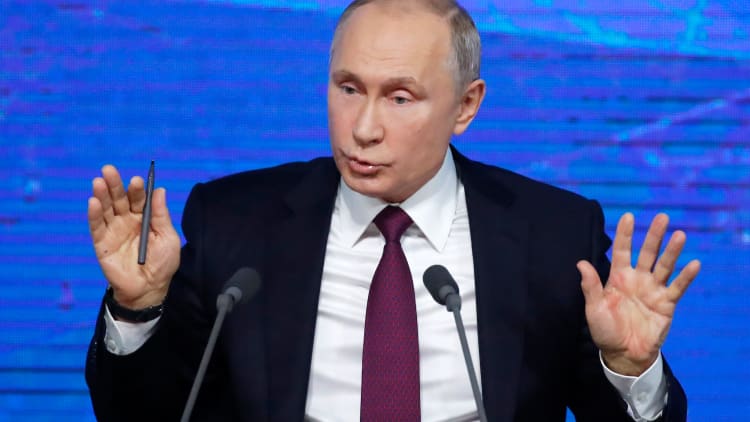WASHINGTON — Russia has conducted another successful test of its ship-based hypersonic missile, a weapon the United States is currently unable to defend against, according to two people with direct knowledge of a U.S. intelligence report.
The people, who spoke to CNBC on the condition of anonymity, said Russia has carried out five total tests of its ship-based hypersonic missile since 2015.
The last known test of the device, dubbed "Tsirkon," was successfully conducted Dec. 10 and reached a top speed of Mach 8, approximately eight times the speed of sound, or about two miles per second.
"What we are seeing with this particular weapon is that the Russians designed it to have a dual-purpose capability, meaning, it can be used against a target on land as well as a vessel at sea," one source explained. "Last week's successful test showed that the Russians were able to achieve sustained flight, a feat that is crucial in the development of hypersonic weapons."

The U.S. intelligence report, according to one source, noted that production of the missile is slated to begin in 2021 and it will join the Kremlin's arsenal no earlier than 2022.
The latest development means the U.S. will have to make up even more ground as Russia and China bolster their arsenals with hypersonic weapons at a breakneck pace.
Yet, James Acton, co-director of the Nuclear Policy Program at the Carnegie Endowment for International Peace, countered notions that Russian and Chinese developments would eclipse U.S. hypersonic efforts.
"I don't necessarily agree with the characterization that the U.S. is on its back foot. All of the evidence I see is that the U.S. has significantly more ambitious goals than the Russians and Chinese," he said. "I don't want to pretend that these developments are irrelevant and that the U.S. can just ignore them. Clearly, there is a qualitative increase in the threat level with the development of a missile like Tsirkon, which is significant."
Acton added: "But my point is that the breathless reaction you often hear to these developments, I think, can be overestimated."
Read more: Hypersonic weapons: What they are, and why the U.S. can't defend against them
The revelations about the ship-based missile come a little more than nine months after Russian President Vladimir Putin touted his nation's growing hypersonic arsenal as "invincible." Moscow's sprint to field this new breed of weapon has sparked fears over a budding arms race.
"I want to tell all those who have fueled the arms race over the last 15 years, sought to win unilateral advantages over Russia, introduced unlawful sanctions aimed to contain our country's development: You have failed to contain Russia," Putin said during his March national address.
Of the six weapons Putin unveiled in March, CNBC has learned that two of them will be ready for war by 2020, according to sources with direct knowledge of U.S. intelligence reports.
Meanwhile, the Pentagon awarded two multimillion-dollar hypersonic weapon contracts to Lockheed Martin earlier this year.
When asked about Moscow's race to develop hypersonic weapons, the Pentagon reiterated an outstanding request to bring Russia back into compliance with the Intermediate-Range Nuclear Forces, or INF, Treaty.
"U.S. concerns right now are focused on bringing Russia back into compliance with current treaties and international agreements," Defense Department spokesman Eric Pahon told CNBC.
In October, Trump announced his decision to withdraw from the INF Treaty, a Cold War-era agreement between the world's two greatest nuclear powers.
Russia, Trump said, has violated the arms agreement by building and fielding the banned weapons "for many years."
The treaty, signed in 1987 by President Ronald Reagan and Soviet Union leader Mikhail Gorbachev, prohibited the development and deployment of midrange nuclear-tipped missiles. The agreement forced each country to dismantle more than 2,500 missiles with ranges of 310 to 3,420 miles from their arsenals.
In short, the treaty has kept nuclear-tipped missiles off the European continent for the last 30 years.
On Thursday, Putin criticized the U.S.′ move to withdraw from the nuclear treaty and warned that a nuclear war should not be discounted.
"They're making another step, and they are withdrawing from the INF treaty, so what's going to come out of that? It's hard to imagine what will come next," Putin said during an annual news conference.


